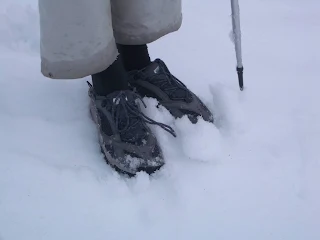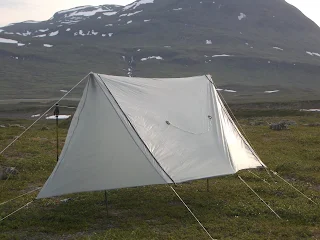By Jörgen Johansson
(This article has, more or less, been published in Swedish before. Please not it was published in 2008, Costs mentioned will not be the same when you read this).
Having been on the peak before, in winter and with everyhing covered in clouds, I could advice that if Jakob wanted to be sure to actually see something from the top, we needed some leeway. If the weather was bad it was essential that we had time to wait.
We landed on planning for a weeks hike, which in practice meant 5-6 days of hiking and the rest travel to and from the mountain. The idea was to go from the trailhead in Nikkaluokta to the foot of Kebnekaise in one day, and then make an ascent along the Western route the next day. If this did not work we would stay in the neighborhood and always have the Durling route or the Western route within reach if the weather looked promising.
 |
The three big ones
The basis for all lighpackingt is to reduce the weight of the big three; wear, shelter, sleep. So during the winter I made an ultralight backpack of some smaller caliber than my own homemade of 600 grams of Jacob. The weight of his pack landed at 225 grams, plus a waist belt /waist bag of 135 grams. This serves takes the load of the shoulders since you sort of have the pack 'standing' on the fanny pack. The pack and belt holds about about 50 liters.
A light and warm sleeping bag was purchased. We planned that I myself and other family members also could use the same bag in other contexts. For summer hiking in our nordic the mountains, I want a sleeping bag that can handle approximately zero degrees.The choice fell on a Marmot Hydrogen L which weighed 685 grams. Expensive, but has seen much use since then. I myself would use my homemade down quilt that weighed 600 grams.
As a sleeping pad and also serving as a back plate for the backpacks, we chose two Thermarest Short weighing 525-600 grams depending on thickness. I did of course hog the thickest for my weary old bones. We also carried two very light and cheap Jysk closed cell pads weighing around 150 grams each. These were used for breaks on rough terrain and to insulate our legs and feet while sleeping, since the Thermrests were only 1200 mm long. A great setup that I still use, with a Neoair these days.
 |
| Marmot Hydrogen, 685 grams. In the background the homemade quilt of 600 grams |
The third heavy part of the gear was the home-sewn tarptent at 525 grams. To this was added our individual mosquito tents that did weigh 200 grams each. This is probably a shelter that is a little too austere for most families with children. Now, Jakob was a hardy kid and with his 13 years he was no toddler, but my opinion is that with children you should invest in a somewhat heavier sturdier shelter than a lightpacker might ordinary choose. But it was cheap and did not weigh more than some 900 grams in all, which was pretty light for a two man shelter 2006.
Having a space that makes you feel protected all around and where you can cuddle up and read when the weather is bad, is worth carrying. With kids you will likely spend more time in your shelter than with adults or on your own. So some extra margins for shelter are recommended for trips with kids.
 |
| The tarptent with lines around ready to pack. About the size of a loaf of bread. |
Personal equipment
My initial idea was that Jakob should carry his own personal equipment, I would carry mine plus everything else such as tents, cooking gear and safety equipment.
This meant that in Jacob's backpack in addition to sleeping pad and sleeping bag you also found his raingear. This was a ligth and inexpensive set, costing approximately SEK 600 and weighing some 500 grams for jacket and pants. This rain suit was also the right size for my wife, which made it an investment not only for this trip. Since I like hiking with an umbrella Jakob was also furnished with one.
There was also a fleece jacket, down vest, fleece hat, gloves, pile socks for camp and sleep, and a pair of waterproof socks from Sealskinz to use in cold and wet weather. A cup, spoon and an eating bowl Pack base weight, that is what Jakob carried all the time was 4.5-5 kilos.
 |
| Jakob's eating utensils; spoon 10 grams, cup 40 grams and bowl 17 grams |
We both wore thin, short sleeved synthetic shirts of no particular brand and bought really cheap. This was keeping in style with our thin synthetic trousers and so called water sport shoes with mesh uppers. We both used walking poles and mine were also used as tent poles.
 |
| Wearing mesh shoes and thin socks in snow coming down from the Pyramid Pass is not as cold as you might think |
Is lightpacking for the whole family not terribly expensive, one might ask. Well, and maybe...not. As we have calculated here on Fjaderlatt.se several years ago, light gear is approximately 1 SEK cheaper per gram than traditional gear. Meaning that a 2000 gram pack costs about 1000 SEK more than a 1000 gram pack.
 |
The
waist belt for Jakobs pack. The pack 'stands' on the fanny pack and
some hip padding has been added, as well as a silnylon pouch for map and
compass. |
The water sport mesh shoes were used as sneaker to school every day until winter after the trip, so no extra cost really. Thin nylon socks are not expensive and the fairly light rain jacket and pants have already been mentioned. Same brand that Gustav from The Bearable Lightness used on the infamously wet Vålådalen trek this year.
 |
Morning in the open tarptent (510 grams) |
Keep in mind if you plan for a trip for several children and adults that everyone does not have to fit into one tent. A slightly larger tent with a foretent might be used for the family get together and then two persons can sleep in a smaller shelter beside the larger one. Depending on the age of the kids they might want one parent in each tent or they might want to sleep on their own.
 |
| Having some snacks on top of the Pyramid Pass, one of the classic high alpine passes in the Swedish Mountains |
There is no doubt that the low weight of our packs ensured that Jakob had a great hike and could enjoy some really strenous passages well away from the trails and the more frequented parts of this alpine area. Not to mention how nice it was for dad not to have to lug a 25 kilo pack across the Pyramid Pass.





Comments
Post a Comment